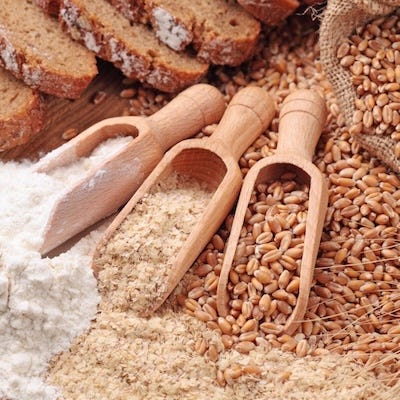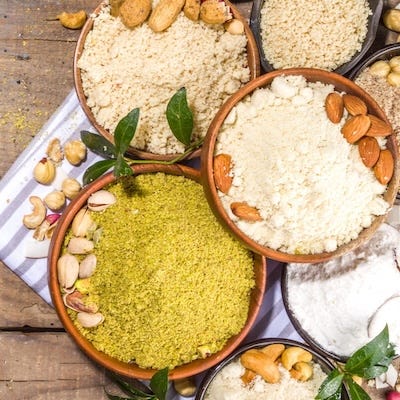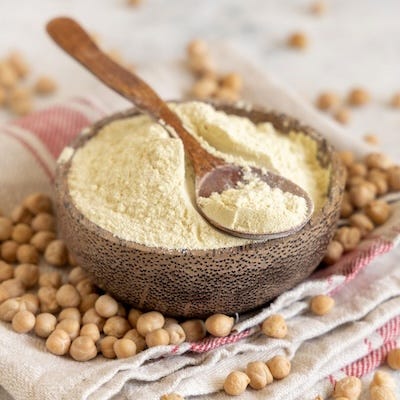I was in the “only buy all-purpose flour” camp for a loonnngggg time. I’m not alone.
It all changed in 2020, when we jumped on the “bread train” that took the world by storm after the world shut down. We stocked up on flour and started baking.
Shortly after, my daughter went back to school to become a pastry chef, and the flour education went into hyperdrive for both of us.
Today, if you were to peer into my pantry, you would find multiple bags of flour. Yes, all-purpose is there. Bread flour, definitely. I have pastry flour, rye flour, chickpea flour, and more.
A lot of talk about gluten-free is in the media now, and for good reason. But the more you understand what all this means, the more choices you can have for what you bring into your own kitchen.
Why are there different types of flour?
Different types of flour bring different qualities to your food supply. It changes protein content, texture, and how you process it.
Flour’s protein content affects gluten development. That ultimately impacts the structure and texture of your final product. You’ll find high-protein flours in chewy breads, and low-protein flours in more delicate foods like cakes and pastries. Course flours add more bite and substance, while fine flours create a more delicate texture.
Protein is what forms gluten in the dough. More gluten means a stronger, stretchier dough, which is required for those airy loaves of bread you often enjoy. Gluten is what gives bread the “elasticity” we’ve all come to love.
In your own home kitchen, you often have a bag of all-purpose flour on your counter. If a recipe calls for flour, all-purpose is the winner. It works.
Yet if you’re trying to make bread, bread flour has more protein than all-purpose. That’s probably why a lot of your recipes don’t turn out. According to King Arthur Baking Company:
“If you make a bread dough with all-purpose flour, the gluten network won’t be as strong because of the lower protein content; this means the dough won’t be able to stretch as much to accommodate those bubbles, resulting in smaller bubbles and bread with a tighter crumb.”
Today’s flour is different from the past
Wheat is the most widely grown crop on the planet. It’s been a staple in our modern diets for generations. Yet, there’s a problem today. Gluten intolerance and what is known as “wheat belly” are at all-time highs. There’s a reason for that.
Modern wheat depends on synthetic fertilizers and herbicides. We place chemicals like glyphosate in the seed, use it to control weeds, and spray it directly on the harvest to dry it faster. It’s safe to say that the wheat we eat today isn’t even close to what our relatives ate a century ago. And it’s showing up as gluten intolerance, among other things.
Even if it doesn’t seem to affect your health, experts will tell you it does. Celiac disease is growing in diagnosis, causing many different responses, from allergic reactions to skin problems to intestinal disorders.
Add in the fact that modern wheat is less nutritious. Monocropping is taking its toll, creating a modern wheat that is significantly lower in minerals like copper, iron, magnesium, manganese, and zinc. Scientists have created crops purposely built for high yield, but lowered the nutrition and flavor levels in the process.
It’s important to note that modern wheat is in more things than you realize. Bread, pastries, and pasta are just the start. It’s also hidden in many products, including soups, sauces, meat products, potato chips, candy, and even ice cream. Many vitamin supplements and pharmaceuticals also use wheat because of its adhesive properties. It’s everywhere, and it’s not going away anytime soon.
Hi there and welcome to Roots! I'm so glad you're here. If you're enjoying what you're reading so far and haven’t subscribed yet, please click that button:
And if you like this post, please tap that heart button ❤️ and leave a comment as that helps the algorithm push this content out to more like-minded souls who might enjoy it. Thank you for being here!
Alternative flour
So, let’s talk about alternative flour. Why so many, and what are they used for?
All-purpose flour
This is the workhorse of flour. It has a protein count somewhere in the middle, meaning it can be used for a variety of purposes and still produce quality results.
This might be a time to go into bleached and unbleached flour because it’s most prevalent in all-purpose. Bleached is treated with chemicals like chlorine and benzoyl peroxide to give it a whiter appearance and softer texture. This bleaching process can further take away flour’s nutritional content. Unbleached flour is naturally aged and will have a darker color and denser texture. It will also have richer flavors and a denser texture.
I choose unbleached, organic flour when I buy it. But, in any case, for most of your everyday cooking and baking, all-purpose flour can get the job done. It works well at breading savory foods or making cookies and cakes.
Whole wheat flour
During processing, wheat kernels are broken down into three parts: endosperm, germ, and bran. Standard white flour uses only milled endosperm, but whole wheat flour uses all three. That gives it more nutritional value and more flavor. You can use it for many of your everyday cooking needs, but keep in mind it will produce a denser product. I especially like it in bread, such as rolls, crackers, and pizza crust.
Bread flour
Bread flour will have one of the highest protein counts. That means your final bread product will have a more porous, chewy texture, and produce that brown, crisp crust we’ve all come to love. I make a delicious focaccia that uses half bread flour and half all-purpose, and have fallen in love with the results. I’ve used this recipe for several years … it’s good.
Cake flour
Cake flour will have the lowest protein content. That gives it a very fine texture - something you want when baking softer foods. If you’ve ever made muffins or scones and not been thrilled with the results, try it again with cake flour. You might find more tender, moist results.
Self-rising flour
I don't buy this, but I thought I’d mention it. Self-rising flour has baking powder and salt mixed in. If time is an issue and you want fast results, you can grab this flour and go. However, if you only have so much space in your pantry (like I do), this is one flour you can leave out and just mix it in yourself, according to the recipe.
Oat flour
I love oat flour! My daughter makes a lovely waffle using oat flour, which we use in one of our go-to comfort meals in the winter, chix-n-waffs. (Yes, it’s vegan style, with crunchy tofu bits to go along with the oat waffles. Yum!) You can make oat flour easily - just keep a bag of organic oats on hand, and grind it in your food processor whenever you need it.
Almond flour
Almond flour is good at making things gluten-free. But it’s not a 1-for-1 tradeoff when adding flour to recipes. I find it’s finer, denser than all-purpose flour. It has a slightly sweet, nutty taste that is good for desserts. Plus, it offers protein, healthy fats, and fiber to whatever you’re making. This should keep this in your fridge or freezer for peak freshness. I suggest using recipes created using almond flour first as you develop your sense of how to use it in your creations. I’m a huge Bob’s Red Mill user, and they have a selection of recipes you can try.
Chickpea flour
Chickpeas are a staple in any plant-based diet. Why not use them in your baking too!? Also known as garbanzo bean flour, when ground, it creates a sweet, rich flavor in baked goods. Because chickpeas are a staple in Middle Eastern and Indian cooking and baking, chickpea flour is a great substitute when added to dishes like falafels, hummus, or soccas. Seriously, you have to try soccas.
Spelt flour
As you dive into plant-based recipes more, you’ll come across spelt flour in a variety of recipes. This is a whole wheat flour milled from an ancient grain called spelt. It behaves much like all-purpose flour, so you can use it interchangeably. People are turning to spelt flour more because it’s considered easier on the digestive system, and is richer in nutrients.
Kamut flour
Are you gluten-sensitive? Kamut might be an answer. Kamut khorasan wheat is an ancient grain organically grown and known for being digestible. It has a sweet, nutty flavor and firm texture. Kamut grain is a great source of protein, fiber, and many vitamins and minerals. I’m still experimenting with this flour, but I’m enjoying the results so far.
Do you really need more than one?
Again, this is a personal choice. But I’m finding having multiple flours in my pantry makes me a better cook.
I consider my options before baking or cooking. I’m learning how to incorporate different flavors into everything I produce. And then there’s nutrition … Just knowing how they manufacture modern-day wheat has sent me into search mode, trying to find something a bit healthier for my family.
Have you tried any of these alternative flours? What did you think?
p.s. Did you like this message? It would mean a lot to me if you’d press the ❤️ below if you liked it, left a comment 💬, or shared it with a friend. I’m trying to grow this publication, and I depend on people like you to do so!
And if you’re new here, Welcome! 💐 I’d love to start sharing my message with you if you’re interested in all things plant-powered, proaging, or finding kitchen joy. Subscribe … and then explore my entire archive! Glad to share with you! 🙋🏼♀️











